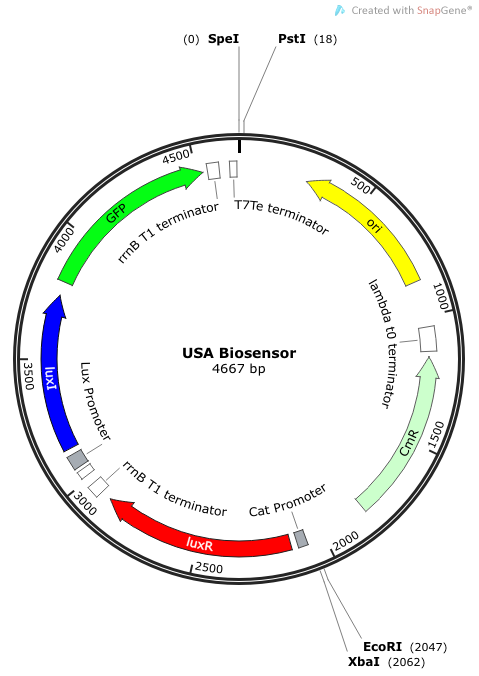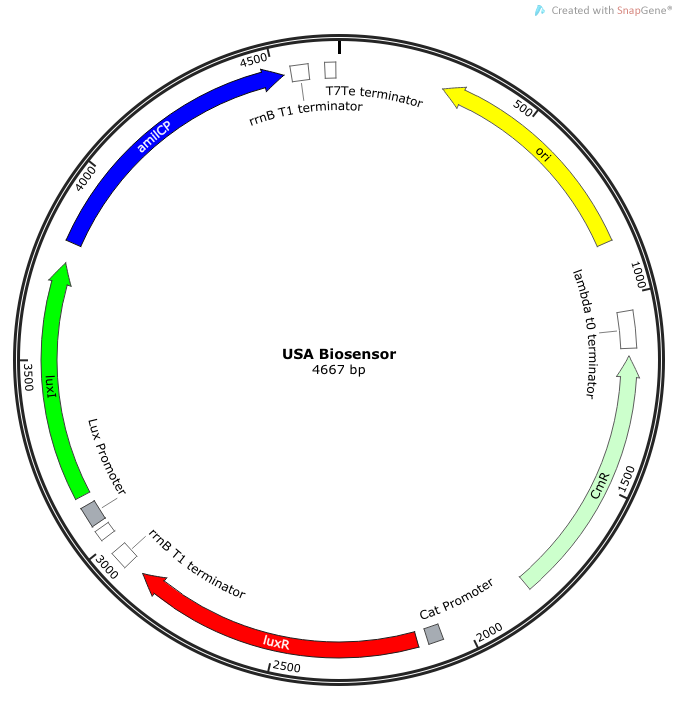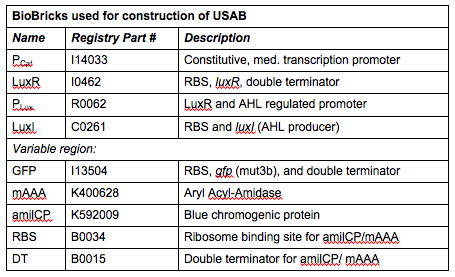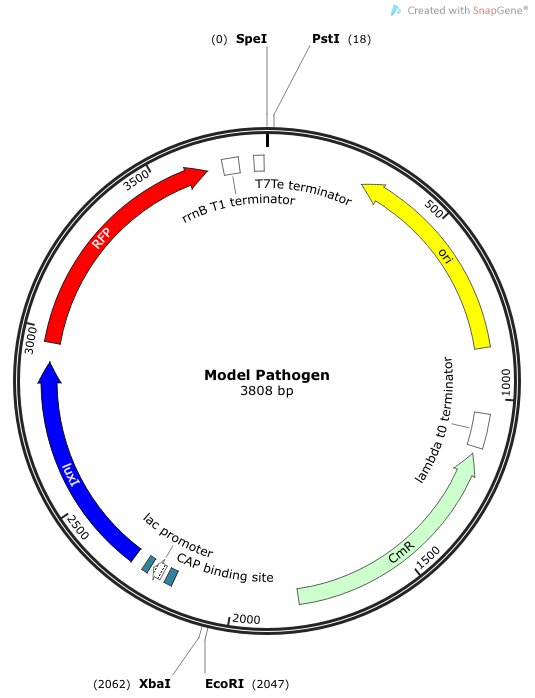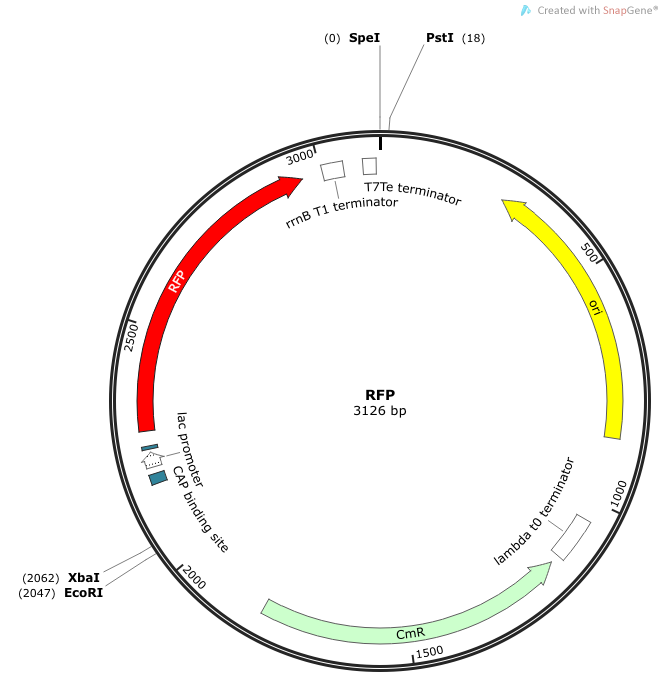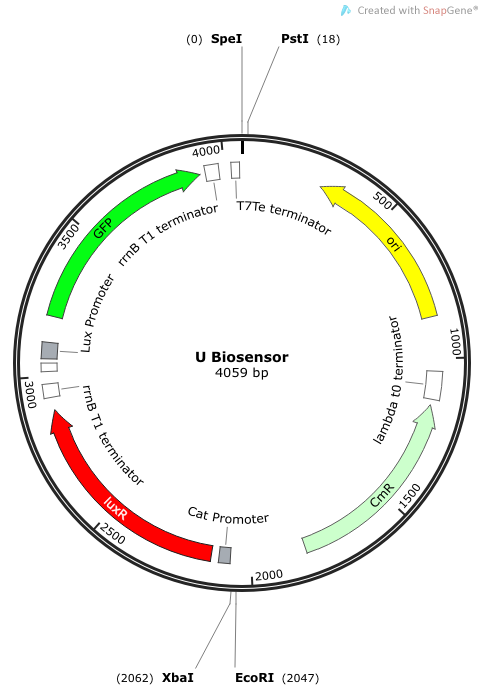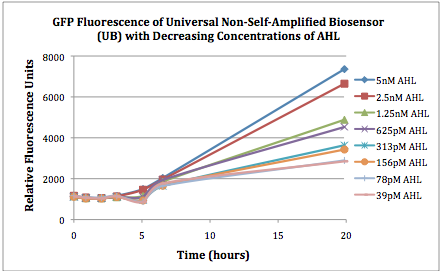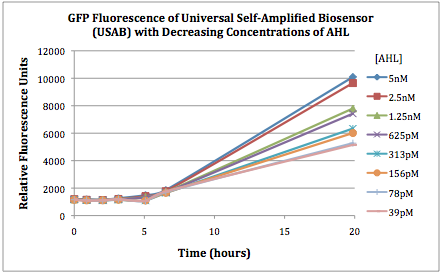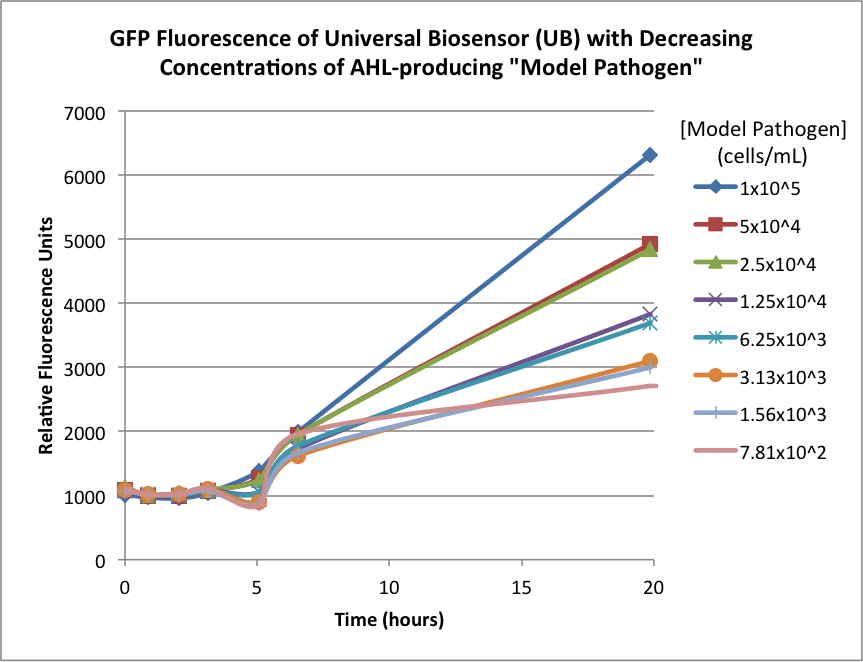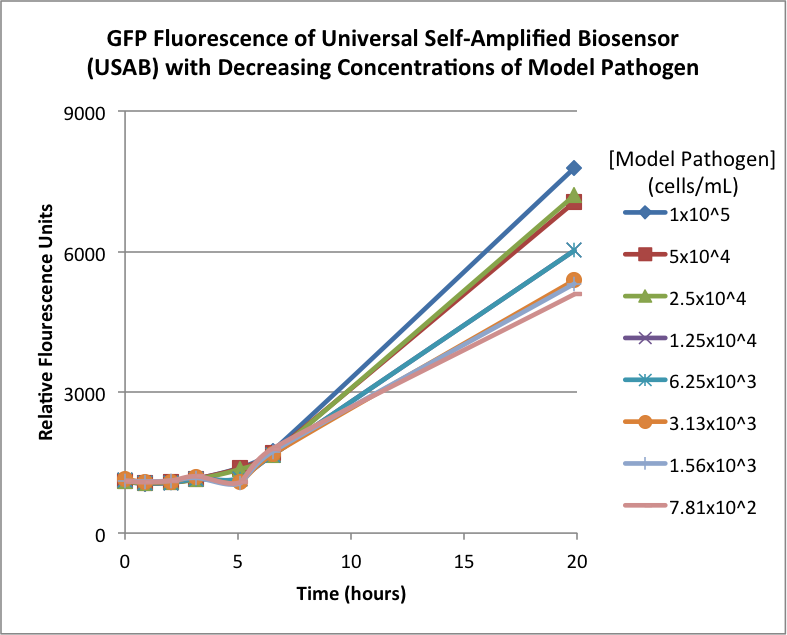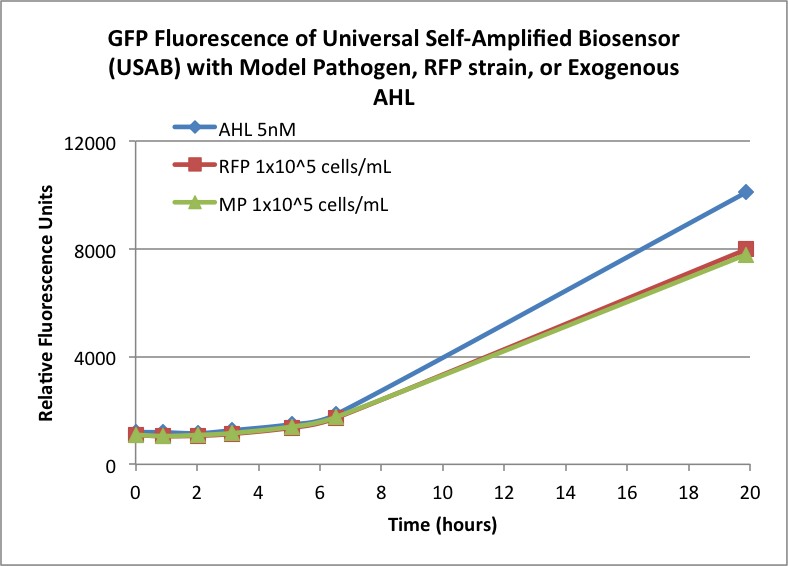Team:Clemson/Notebook
From 2013.igem.org
m |
(→Notebook) |
||
| (12 intermediate revisions not shown) | |||
| Line 12: | Line 12: | ||
We actually decided to make three version of this; each would include the constitutively expressed activator LuxR, the LuxR/AHL activated promoter ''Plux'' followed by the AHL-producing LuxI and a signal output (GFP, amilCP, or mAAA). GFP would, of course, produce a fluorescent signal, amilCP is a blue chromogenic protein, or mAAA would enzymatically convert the colorless acetomenaphin to a reddish compound. The goal was to find out which of the three versions could inherently produce the most easily detectable signal output in the shortest amount of time. | We actually decided to make three version of this; each would include the constitutively expressed activator LuxR, the LuxR/AHL activated promoter ''Plux'' followed by the AHL-producing LuxI and a signal output (GFP, amilCP, or mAAA). GFP would, of course, produce a fluorescent signal, amilCP is a blue chromogenic protein, or mAAA would enzymatically convert the colorless acetomenaphin to a reddish compound. The goal was to find out which of the three versions could inherently produce the most easily detectable signal output in the shortest amount of time. | ||
<br> | <br> | ||
| - | The plasmid | + | The plasmid constructs for the USAB-GFP and USAB-amilCP versions are shown below. The mAAA version would just replace the amilCP or GFP with mAAA. |
<br> | <br> | ||
{| | {| | ||
|[[File:USA Biosensor.png|300px|frameless|center]] | |[[File:USA Biosensor.png|300px|frameless|center]] | ||
| + | {| | ||
| + | {| | ||
| + | |[[File:newUSA Biosensor.png|300px|frameless|center]] | ||
| + | |||
|[[File:CUTable1.png|400px|frameless|center]] | |[[File:CUTable1.png|400px|frameless|center]] | ||
|} | |} | ||
| Line 21: | Line 25: | ||
''Rationale'': I14033 was used because the medium transcription rate would be less energetically burdensome on the cell, and this seemed reasonable for a transcriptional regulator. The purpose of having I0462, R0062, and C0261 was to create a positive feedback loop. I0462 would be activated by an outside source of AHLs thereby activating R0062. R0062 would then drive transcription of C0261 to express LuxI, which is responsible for synthesizing more AHLs to drive I0462. This positive feedback loop is what makes the sensor self-amplifying, thus making a very minute signal from a pathogen become more detectable in smaller concentrations. Detection is made possible by GFP or the colorimetric proteins amilCP and mAAA. | ''Rationale'': I14033 was used because the medium transcription rate would be less energetically burdensome on the cell, and this seemed reasonable for a transcriptional regulator. The purpose of having I0462, R0062, and C0261 was to create a positive feedback loop. I0462 would be activated by an outside source of AHLs thereby activating R0062. R0062 would then drive transcription of C0261 to express LuxI, which is responsible for synthesizing more AHLs to drive I0462. This positive feedback loop is what makes the sensor self-amplifying, thus making a very minute signal from a pathogen become more detectable in smaller concentrations. Detection is made possible by GFP or the colorimetric proteins amilCP and mAAA. | ||
<br> | <br> | ||
| - | ''Note'': We also constructed prototype operons composed of the BioBrick parts R0010 (lac promoter) and I13504 (RBS-GFP-DT), or B0034-K400628-B0015 (mAAA version), or B0034-K592009-B0015 (amilCP version). We qualitatively determined that ligation of R0010 and I13504 and the subsequent transformation of R0010 + I13504 into E. coli was functional due to green florescence under UV light. We were never able to see blue color formation from amilCP or red color formation from mAAA. There may have been a mistake in our process for amilCP (e,g, missing RBS perhaps) to account for our results. See our “Experience” page for mAAA for more info on that. | + | ''Note'': We also constructed prototype operons composed of the BioBrick parts R0010 (lac promoter) and I13504 (RBS-GFP-DT), or B0034-K400628-B0015 (mAAA version), or B0034-K592009-B0015 (amilCP version). We qualitatively determined that ligation of R0010 and I13504 and the subsequent transformation of R0010 + I13504 into ''E. coli'' was functional due to green florescence under UV light. We were never able to see blue color formation from amilCP or red color formation from mAAA. There may have been a mistake in our process for amilCP (e,g, missing RBS perhaps) to account for our results. See our “Experience” page for mAAA for more info on that. |
<br> | <br> | ||
<br> | <br> | ||
| Line 36: | Line 40: | ||
<br> | <br> | ||
<br> | <br> | ||
| - | '''Construction of | + | '''Construction of ''luxI''— “model pathogen”''' |
This is very similar to the “model pathogen” described above, but lacking the C0261 BioBrick part. | This is very similar to the “model pathogen” described above, but lacking the C0261 BioBrick part. | ||
<br> | <br> | ||
| Line 43: | Line 47: | ||
|} | |} | ||
<br> | <br> | ||
| - | ''Rationale'': The luxI-- “model pathogen” construct serves as a negative control for the sake of testing the sensitivity and functionality of the USAB. We wanted to see a high signal output only for the AHL producing model pathogen, but no signal output for the non-AHL-producing strain. | + | ''Rationale'': The ''luxI''-- “model pathogen” construct serves as a negative control for the sake of testing the sensitivity and functionality of the USAB. We wanted to see a high signal output only for the AHL producing model pathogen, but no signal output for the non-AHL-producing strain. |
<br> | <br> | ||
<br> | <br> | ||
| Line 59: | Line 63: | ||
'''Phase IV: Testing the Biosensors''' | '''Phase IV: Testing the Biosensors''' | ||
<br> | <br> | ||
| - | E. coli DH10B cultures hosted all the plasmid constructs. A total of four cultures were used: the universal sef-amplified biosensor (USAB), the universal non-self-amplified biosensor (UB), the “model pathogen” (MP), and the negative control non-AHL-producing “model pathogen” (RFP). See above for details on the plasmid constructs of each culture. | + | ''E. coli'' DH10B cultures hosted all the plasmid constructs. A total of four cultures were used: the universal sef-amplified biosensor (USAB), the universal non-self-amplified biosensor (UB), the “model pathogen” (MP), and the negative control non-AHL-producing “model pathogen” (RFP). See above for details on the plasmid constructs of each culture. |
<br> | <br> | ||
Cultures of USAB, UB, MP, and RFP were inoculated into M9 Miller medium supplemented with glucose, thiamine, casamino acids, and IPTG. These cultures were grown overnight at 37oC with shaking. The following day, the cultures were harvested by centrifugation, washed, and resuspended in fresh medium. They were then diluted 1:100 into fresh medium and incubated further. The OD600 was not allowed to surpass 0.1 to keep them in very early log phase. After a few generations of growth (determined via increase in OD600) the cultures were again harvested and resuspended in fresh medium to set concentrations—1x10^7 cells/mL of the biosensor cultures (UB and USAB), and 1x10^3 cells/mL or a maximum of 1x10^5 cells/mL for the MP and RFP cultures. | Cultures of USAB, UB, MP, and RFP were inoculated into M9 Miller medium supplemented with glucose, thiamine, casamino acids, and IPTG. These cultures were grown overnight at 37oC with shaking. The following day, the cultures were harvested by centrifugation, washed, and resuspended in fresh medium. They were then diluted 1:100 into fresh medium and incubated further. The OD600 was not allowed to surpass 0.1 to keep them in very early log phase. After a few generations of growth (determined via increase in OD600) the cultures were again harvested and resuspended in fresh medium to set concentrations—1x10^7 cells/mL of the biosensor cultures (UB and USAB), and 1x10^3 cells/mL or a maximum of 1x10^5 cells/mL for the MP and RFP cultures. | ||
| Line 72: | Line 76: | ||
<br> | <br> | ||
{| | {| | ||
| - | |[[File: | + | |[[File:CUfigure1UB.png|400px|thumb|center|Figure 1A]] |
| - | |[[File: | + | |[[File:CUfigure2USAB.png|400px|thumb|center|Figure 1B]] |
|} | |} | ||
<br> | <br> | ||
| Line 83: | Line 87: | ||
|} | |} | ||
<br> | <br> | ||
| - | Figures 3A and 3B show the response of the UB and USAB, respectively, to AHL (5nM), “model pathogen” ( | + | Figures 3A and 3B show the response of the UB and USAB, respectively, to AHL (5nM), “model pathogen” (1x10^5 cells/mL), or RFP strain (the non-AHL-producing model pathogen at 1x10^5 cells/mL). Unexpectedly, the relative GFP emission appears to increase over time regardless of whether the strain present produces AHL. This could mean the fluorescence is increasing only as the biosensor strain grows, with GFP expression per cell remaining relatively constant. However, the presence of AHL does seem to increase the slope of fluorescence. |
<br> | <br> | ||
{| | {| | ||
Latest revision as of 01:31, 29 October 2013
Notebook
|
|
 "
"

